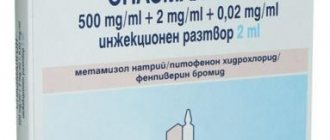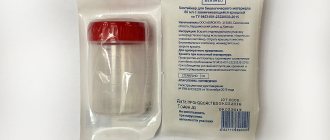One of the most powerful diuretics is the diuretic Lasix. This medication is highly effective and has a minimal number of serious side effects. An important advantage of Lasix is the presence of various dosage forms and due to this it can be used in all kinds of situations, both planned and critical. This pharmaceutical drug should be used only as prescribed by a specialized specialist and exclusively in the doses indicated by him.
Composition and action
The main component of the decongestant drug is furosemide. A loop diuretic acts on the loop of Hengle, exhibits a noticeable diuretic effect, and quickly removes excess fluid and toxins. The sulfonamide derivative inhibits the reabsorption of sodium chloride in the loop of Hengle.
Additional benefits from using Lasix:
- increasing the volume of urine excreted;
- activation of potassium production in the renal tubules (distal);
- accelerated removal of calcium and magnesium ions from the body;
- decrease in blood pressure against the background of a decrease in the volume of circulating blood, a vasoconstrictor effect, and active excretion of Na;
- reduces preload in heart failure, reduces filling pressure in the pulmonary artery and left ventricle;
- excretion of urine and sodium salts begins at a dosage of 10 to 100 mg of furosemide. When administered intravenously, the patient feels the diuretic effect after 50 minutes, the effect lasts up to three hours;
- To achieve optimal results, doctors administer the solution infusion for one and a half to two minutes.
Find out the instructions for using Furamag tablets for the treatment of urological pathologies.
Read about how to collect tests for the Reberg-Tareev test and what the results show in this article.
Pharmacological properties of the drug Lasix
Furosemide (4-chloro-N-(2-furylmethyl)-5-sulfamoylanthranilic acid) is a fast-acting diuretic, a sulfonamide derivative. The mechanism of action of Lasix is due to the blockade of reabsorption of chlorine and sodium ions in the ascending limb of the loop of Henle. To a lesser extent, the drug also affects the convoluted tubules, and this effect is not associated with inhibition of carbonic anhydrase or antialdosterone activity. Lasix has a pronounced diuretic, natriuretic, chloruretic effect. Increases the excretion of potassium, calcium, magnesium. When administered intravenously, it quickly reduces preload on the heart, left ventricular filling pressure and pulmonary artery pressure. Reduces systemic blood pressure. When taking the drug orally, the diuretic effect is noted within 1 hour, and the maximum effect is achieved within 1–2 hours after administration; the duration of the diuretic effect is 6–8 hours. With intravenous administration, the onset and maximum diuretic effect are observed respectively 5 and 30 minutes after administration, and its duration is about 2 hours. When taken orally, the bioavailability of Lasix is 64%. The maximum concentration of the drug in the blood plasma increases with increasing dose, but the time to reach the maximum does not depend on the dose and varies widely depending on the patient's condition. The half-life is about 2 hours. After intravenous administration, the amount of Lasix excreted in the urine is significantly greater than after oral administration. In blood plasma, the drug is mainly bound to protein, mainly albumin: in the concentration range from 1 to 400 ng/ml, protein binding in healthy individuals is 91–99%. The free fraction is 2.5–4.1% of the therapeutic concentration. During the biotransformation process, the drug in the body is converted mainly into glucuronide.
Indications for use
Why is Lasix prescribed? A fast-acting remedy is prescribed for pronounced edema syndrome. Liquid form and tablets are available with a prescription. A powerful loop diuretic should not be taken uncontrolled: furosemide actively removes salts, often provokes side effects, and is not allowed for all pathologies accompanied by excessive fluid accumulation.
Lasix is prescribed in the following cases:
- edema syndrome in chronic renal failure, acute and chronic heart failure, severe liver pathologies;
- to maintain forced diuresis against the background of the action of chemicals that do not undergo metabolism in the body;
- hypertensive crisis;
- cerebral edema;
- development of renal failure due to burns;
- nephrotic syndrome with a noticeable accumulation of fluid in the body.
Directions for use and dosage
Injections are given and droppers are given to patients if oral administration of the drug is impossible, or in cases of pronounced edema. The dosage is selected by the attending physician individually for each patient. Begin taking the drug with the smallest doses that are sufficient to produce the desired effect. In case of heart pathologies, swelling is relieved by drinking 20-80 mg of Lasix per day. If edema syndrome occurs due to hypertension, then it is recommended to take the diuretic medication 80 mg per day, dividing the dose into 2 doses: in the morning and in the afternoon. For pulmonary edema, the diuretic is administered intravenously at first 40 mg and, if necessary, after half an hour another 20-40 mg.
Lasix is the trade name of a drug whose active ingredient is furosemide. It is taken to reduce swelling caused by heart failure, kidney problems, and cirrhosis of the liver. Some people take Lasix for high blood pressure, as an emergency treatment for hypertensive crises. Below you will find instructions for using this drug, written in clear language. Study its indications, contraindications and side effects. Find out how to take Lasix correctly: how many days in a row, in what dosages, how to combine Asparkam and Panangin with medications. Understand why torasemide is replacing Lasix (furosemide) in the treatment of heart failure and hypertension.
Drug card
Contraindications
The drug is not suitable for premature babies: the possibility of developing nephrolithiasis, nephrocalcinosis. During pregnancy and nursing mothers, a powerful diuretic should not be used.
Time restrictions for using Lasix:
- decreased protein levels;
- gout;
- low blood pressure;
- development of diarrhea;
- acute stage of myocardial infarction;
- stenosis of coronary vessels, other problems with blood vessels and heart, in which it is impossible to sharply reduce blood pressure;
- development of ventricular arrhythmia;
- hearing loss;
- problems with fluid excretion due to prostate hyperplasia, narrowing of the urethra, hydronephrosis;
- diabetes;
- hereditary disease - systemic lupus erythematosus;
- pancreatitis.
Absolute contraindications:
- allergic reaction to furosemide, excipients;
- a sharp decrease in sodium levels;
- renal failure, anuria, in which the administration of the solution does not give a positive result;
- pronounced problems in urine excretion;
- coma, hepatic precoma.
Side effects of Lasix
With long-term use or administration of the drug in high doses - hypovolemia, dehydration, hemoconcentration with a tendency to thrombosis (especially in the elderly), hypokalemia, hyponatremia, hypochloremia, alkalosis, in some cases - hypocalcemia; arterial hypotension, systemic circulatory disorders (especially in children and the elderly); deterioration of the condition due to obstructive uropathy (prostatic hyperplasia, narrowing of the ureter, hydronephrosis); increased levels of cholesterol and TG in the blood plasma; transient hyperuricemia (with exacerbation of gout), increased creatinine levels; hyperglycemia, especially in patients with diabetes; increased severity of metabolic alkalosis; nausea, vomiting, diarrhea; allergic skin reactions (itching, polymorphic erythema, exfoliative dermatitis, purpura), fever, extremely rarely - anaphylactic shock; extremely rarely - vasculitis, interstitial nephritis; changes in the composition of peripheral blood - eosinophilia, aplastic or hemolytic anemia, leukopenia or agranulocytosis, thrombocytopenia with a tendency to bleeding; In premature newborns with respiratory distress syndrome, the use of furosemide during the first weeks of life increases the risk of patent ductus arteriosus.
Instructions for use
Infusion administration is carried out only by a health care worker. The patient takes Lasix tablets as prescribed by a nephrologist or urologist, with mandatory adherence to the rules. In severe conditions, the patient is in a hospital; when using a loop diuretic at home, it is important to periodically visit a doctor and do tests to monitor electrolyte levels.
Pills
For a particular patient, the doctor selects the optimal dosage taking into account weight, age, and urinary tract condition. It is important to take into account background pathologies. For various types of pathologies accompanied by swelling, the doctor develops a specific treatment regimen. The duration of use of the diuretic is also recommended by the doctor.
The best option is to take the minimum dosage (20 to 40 mg) to reduce the risk of side effects. For children, the daily dose is calculated based on the recommendations: per 1 kg of body weight - 2 mcg, but not more than 40 mg in 24 hours. The maximum daily dosage for adult patients is no more than 1500 mcg.
Solution for intravenous administration
The drug Lasix accelerates the elimination of fluid: you can lose up to two kilograms of body weight per day. With intravenous infusion, the greatest therapeutic effect is manifested. Depending on the type and severity of the pathology, doctors provide continuous infusion therapy at a rate of 50 to 100 ml per hour.
For intravenous administration of a powerful diuretic, the recommended initial dose is 40 mg. When carrying out chronic hemodialysis, it is important to maintain the maintenance rate of furosemide - from 250 to 1500 mg per day. For nephrotic syndrome, 20 to 40 mg of the active ingredient is sufficient.
Important! While using the loop diuretic Lasix, the patient noticeably loses potassium. The result is disruptions in the functioning of the heart, negative symptoms when the water-electrolyte balance is disturbed. A diet based on foods rich in potassium is required: tomatoes, dried apricots, bananas, cauliflower, raisins, nuts, baked potatoes. If a special diet does not restore K levels, the doctor prescribes potassium supplements and potassium-sparing drugs.
Customer Reviews
Semyon K., Tula:
“Lasix diuretic tablets have proven themselves to be a powerful diuretic that allows you to quickly get rid of swelling caused by intoxication and other diseases. Among the main advantages are the low price, as well as easy accessibility (you can find the drug in almost any pharmacy), however, caution should be exercised during use, which is justified by the presence of Furosemide in the composition. I told the doctor about the medications I was taking and how long I had been taking them, and I was lucky - I have no side effects from taking them together. As a result, I was able to successfully get rid of the swelling.”
Roman T., Sochi:
“Chronic heart failure caused swelling of the lower extremities, which at first was noticeable only in the morning, but over time became persistent. In addition, they began to be accompanied by shortness of breath, which is why I began to experience constant problems (especially in hot weather, when any walk around my hometown turned into a real test). It was impossible to delay treatment. I came to see a doctor, who recommended that I use Lasix diuretic tablets and left a good detailed review about them. Within 3 days, due to the powerful diuretic effect on the body, I noticed that the swelling became much less, and after a week it disappeared completely, and along with it shortness of breath.”
Adverse reactions to the drug
It is important to find out whether there are any restrictions, what is the individual sensitivity, and whether a powerful diuretic has been used before. The patient should know what negative manifestations are possible even if the instructions are strictly followed.
After administering the solution or using Lasix tablets, unwanted reactions sometimes develop:
- violation of water-electrolyte and acid-base balance;
- pain appears in the injection area;
- Blood pressure drops sharply, the volume and speed of blood circulation decreases, arrhythmia or tachycardia, collapse develops;
- cramps appear, muscle weakness is felt;
- the concentration of uric acid increases;
- the level of serum cholesterol, triglycerides, creatinine, urea increases;
- diarrhea, vomiting develops, the patient feels sick;
- possible acute pancreatitis;
- ALT and AST indicators are violated;
- headaches, drowsiness, paresthesia, weakness appear, blurred vision, tinnitus, and dizziness;
- skin reactions appear: urticaria, bullous rashes, purpura, erythema multiforme, dermatitis, anaphylactic reactions;
- the composition of the blood is disturbed: thrombocytopenia, leukopenia, eosinophilia, hemolytic or aplastic anemia, agranulocytosis develops;
- intoxication develops against the background of partial narrowing of the urethra, interstitial nephritis and the appearance of kidney stones in premature infants are possible.
Warning! Lasix is a loop diuretic with a powerful diuretic effect. Active loss of magnesium and calcium often causes heart problems, a sharp drop in blood pressure and poor circulation are possible. A loop diuretic is not suitable for the prevention of edema: herbal preparations and herbs with a diuretic effect help remove excess fluid without dangerous consequences. For long-term use (in courses of 2–3 months with a mandatory short break), doctors recommend bearberry, knotweed, corn silk, parsley root, rose hips, and hop cones.
Interaction with other drugs
When prescribing the drug together with glucocorticosteroids and laxatives, the electrolyte composition of the blood should be monitored, because the likelihood of developing hypokalemia increases.
When treated with cephalosporin antibiotics, their level in the blood may increase and then you may be afraid of side effects.
The diuretic effect may be reduced when taken simultaneously with probenecid, phenytoin and NSAIDs.
Combination with ACE inhibitors can lead to increased hypotensive effect and deterioration of kidney function.
Also, a diuretic can enhance the toxic effect of theophylline and lithium drugs.
Overdose symptoms
The higher the level of loss of fluid and various salts, the brighter the negative signs. To restore the concentration of nutrients and prevent dehydration, symptomatic therapy is carried out. It is important to monitor electrolytes and hematocrit until balance is fully restored.
In case of overdose, doctors most often record the following problems:
- apathy;
- thrombosis;
- acute renal failure;
- decreased blood pressure;
- heart rhythm problems;
- flaccid paralysis;
- dehydration;
- confusion;
- delirium.
How to take Lasix for weight loss
With intravenous injection, the effect develops within five minutes and lasts a couple of hours. Indications for complex therapy: Edema of various origins associated with diseases of the cardiovascular system, kidneys, pregnancy, intoxication. Edema of the brain and spinal cord, intracranial hypertension, pulmonary edema as emergency treatment methods.
High blood pressure. Insufficiency of kidney functions. Contraindications for use: a history of allergic reactions to such drugs, as well as any signs of hypersensitivity of the body, acute glomerular nephritis, failure of kidney function, accompanied by a lack of urine flow into the bladder, coma caused by severe liver diseases, impaired water-salt balance and acid alkaline state, especially low potassium and sodium levels.
Side effects include: Hypotension. Dryness and discomfort in the mouth, dry mucous membranes, thirst. Dyspeptic disorders, nausea, vomiting, vague abdominal pain, constipation, frequent loose stools.
Inflammation of the pancreas. Hypovolemia, dehydration, decreased levels of potassium in the blood below normal, sodium, chlorine, calcium and related disorders, increased concentration of uric acid in the blood. Inflammation of the skin and its appendages, impaired hearing, vision, crawling sensation on the skin, tingling, numbness, systemic and non-systemic dizziness, muscle weakness. Delayed urine output in patients with benign prostate tumors.
Decreased glucose tolerance based on laboratory test. Acute inflammation of the pancreas. The pharmaceutical product is taken orally before meals in the morning. The recommended starting dose is mg orally when administered intravenously in a hospital setting. The frequency of administration and intravenous administration is once a week. Since the drug has many side effects, before the first use it is necessary to consult a specialist and not self-medicate.
Before prescribing the medication, you need to find out the condition of the liver and kidneys, and, if necessary, reduce the dosage or abandon the medication. You must be careful when driving. If side effects occur, consult a doctor to decide on further use of the product. The medication is contraindicated during pregnancy and while breastfeeding the baby.
Cost of loop diuretic
The price of Lasix suits all patients:
- Lasix tablets, 45 pieces - from 45 to 60 rubles;
- ampoules of 2 ml, 10 pieces per package - from 75 to 90 rubles.
Learn about the symptoms of acute hemorrhagic cystitis in women and the treatment of the disease.
About how to correctly collect urine according to Nechiporenko and what the analysis results show is written on this page.
Go to the address and read about the dangers of a kidney cyst and how to treat the formation.
Lasix and Furosemide - what is the difference?
Pharmaceuticals are classified as diuretics or diuretics. The purpose of taking them is to eliminate the accumulation of water in tissues. When purchasing diuretic medications, a natural question arises: how does Lasix differ from Furosemide and what to choose, whether the drugs are the same. In terms of their composition and belonging to the pharmacological group, the medications are identical: the active substance is furosemide, according to the classification they belong to loop diuretics.
The difference between the drugs lies in the manufacturer. Furosemide is produced in Russia or Bulgaria (Sopharma), Lasix - in France or India.
tablets 40 mg (45 pcs)
The release form of the products is the same: tablets and ampoules for injection, the concentration of furosemide in which is completely the same. There is no difference in action between Furosemide and Lasix as loop diuretics.
Lasix: analogues
Pharmacy chains offer many diuretic drugs. The selection of a diuretic is carried out by a doctor: it is important to take into account contraindications, the effect on the urinary tract, and the general condition of the patient.
List of effective diuretics:
- Britomar.
- Torsemide.
- Furosemide.
- Trigrim.
- Diuver.
- Thorsid.
- Toricard.
- Trifas.
Reviews of diuretic tablets and Lasix solution confirm the active diuretic effect. The drug quickly relieves swelling, removes excess stagnant fluid, lowers blood pressure, and reduces the load on the heart. Take the composition with caution, only under the supervision of a doctor. It is important to remember: the fast-acting loop diuretic Lasix often disrupts the water and electrolyte balance. The active substance provokes the loss of salts, which leads to dangerous complications.
What are the benefits of taking powerful diuretics, including Lasix? What foods should medications not be combined with? What should you ask your doctor if he prescribed you diuretics? Listen to useful advice from experts in the following video:
special instructions
The reason for using Lasix with increased caution should be considered a tendency to low blood pressure. You should not prescribe medication if the patient has cerebral vascular stenosis.
Specialists should monitor the administration of Lasix solution to patients with diabetes, gout, and those who have had a heart attack.
Children under three years of age should not take the medicine.
Patients with impaired hearing or nephrocalcitis require constant medical supervision.
In some conditions, additional examination may be required before prescribing the drug.
Compatibility Guidelines
Lasix should not be mixed with other medications in the same syringe.
As for the simultaneous use of various medications, there are several combinations of them with Lasix.
It is not recommended to combine with the following chemicals and compounds:
- chloral hydrate - possible flushing, excessive sweating, overexcitement, nausea, tachycardia and high blood pressure;
- aminoglycosides - their ototoxicity increases, as a result of which irreversible damage to the neurons of the inner ear and auditory nerve is possible, up to hearing loss.
Additional measures must be taken if Lasix is combined with the following medications:
- Cisplatin – there is a possibility of ototoxicity, and the nephrotoxicity of Cisplatin also increases;
- lithium preparations – an increase in the amount of lithium in the blood serum cannot be ruled out, which increases its toxicity, so it is necessary to constantly monitor the level of this chemical element;
- angiotensin-converting enzyme inhibitors - upon first use, severe hypotension and problems with kidney function often appear, so the dose of Lasix should be reduced or discontinued altogether;
- Risperidone - it is necessary to evaluate the benefits and risks, and exercise extreme caution when taking it together with furosemide. The combination of these drugs can cause dehydration, which can result in death. Particular care must be taken when prescribing combination therapy for dementia in elderly patients.
When Lasix is co-administered and:
- non-steroidal anti-inflammatory drugs, aspirin - the effectiveness of the described drug may decrease;
- corticosteroids, licorice root - there is a high probability of developing hypokalemia;
- blood pressure lowering agents – in combination with furosemide, blood pressure drops rapidly;
- Probenecid, Methotrexate - the effect of furosemide is reduced, or these drugs are removed from the body more slowly;
- medicinal compositions against diabetes – lose effectiveness;
- cephalosporins - the risk of kidney dysfunction increases;
- Cyclosporine – possible development of gouty arthritis.
Emergency measures for the development of anaphylactic shock
If the patient develops signs of anaphylactic shock (cyanosis, nausea, weakness, cold sweat), then you should immediately stop administering the drug and leave the needle in the vein. The head and torso should be lowered down, while emergency measures are taken to support breathing function. They include:
- infusion of adrenaline into a vein. The solution is diluted to 10 ml, first inject 1 ml, and if necessary, the rest;
- At the same time, glucocorticosteroids (for example, Prednisolone) are administered in an amount of 250-1000 mg.
If necessary, antiallergic medications are prescribed and artificial respiration is performed.
Use during pregnancy and lactation
The permeability of the active substance of the drug is quite high; it is not difficult for it to overcome the placental barrier. In this regard, Lasix should not be used while expecting a baby. However, if the benefits of using the drug exceed the predicted risks for the mother's health, then the prescription is possible, but the woman must be under medical supervision, and specialists are required to monitor the condition of the fetus.
The use of the product is undesirable during breastfeeding; it can reduce milk production and also penetrates into it.
Prescription in old age
The use of Lasix in elderly patients is possible, but increased caution and close monitoring of the patient's condition should be used, since the processing of furosemide slows down at this age, and the likelihood of side effects increases.
Use for liver and kidney dysfunctions
In case of severe liver dysfunction, especially against the background of cirrhosis or hepatitis, a significant amount of bilirubin (a bile pigment that is not broken down) is released into the blood; it is quite toxic. Lasix helps to quickly remove it along with excess fluid.
If there is impaired renal function, the drug is prescribed only in the absence of urinary retention.
The ability to influence the reaction rate when driving vehicles or other mechanisms
Among the possible undesirable effects of using Lasix is a rapid decrease in blood pressure, in connection with which the quality of concentration and reaction speed can be significantly impaired. Therefore, it is better to refuse to drive a car and work with complex mechanisms.
Terms of sale and storage
In order to purchase medication at a pharmacy, you will need a prescription from your doctor.
Lasix can be stored for three years under standard conditions - it should be kept in a dark place at room temperature.











